An education in olive oil
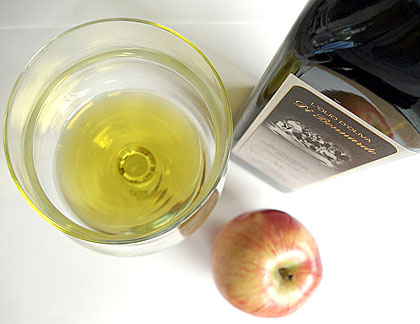
Olive oil is so ubiquitous nowadays that you may not even think twice about it. But the world of olive oil goes so much deeper than you might imagine. It's not just about buying a bottle labeled Extra Virgin and trusting it's all good.
For example, did you know that there are professional olive oil tasters, not to mention juried olive oil contests? That an apple is used as a palate cleanser during an official tasting or contest? That the best olive oil is made from unripe green olives? That if you want the freshest olive oil of the season, the time to buy it is from January until about March? That oil makers often use two or more olive varieties to come up with the unique blend?
I learned about these things and more when we visited the Zürich offices Di Bennardo, a family run olive farm and oil production company in Sicily a couple of days ago for an olive oil degustation (tasting). It was an enlightening and very entertaining experierence, and gave me a greater insight into the world of olive oil, as well as how a small family-run company is marketing its product with pride.
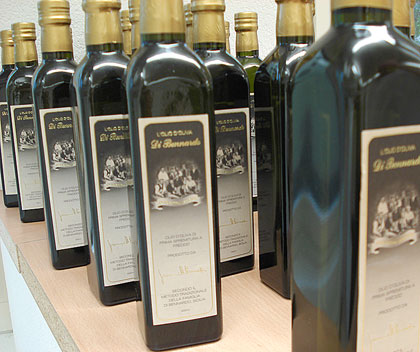
We first read about Di Bennardo olive oil in a recent article in the Neue Zürcher Zeitung (NZZ), the biggest newspaper in Zürich. The article described how a young entepreneur was marketing his family's Sicilian olive oil, an oil that had won several awards both from professionals and from consumers. It also mentioned that Di Bennardo held degustations (tastings). Intrigued, we just had to try. (Normally the degustations are held for groups of 10 or more but they kindly made an exception in our case.) Di Bennardo is a totally family run operation, with the farm and processing plant in the town of Ribera, Sicily and the main office in Zürich.
We were greeted by Giovanni Di Bennardo, the 27 year old owner of the company. After a brief explanation of the background of the company and of how olive oil is made as we sipped a white wine from Sicily, we proceeded to the tasting.
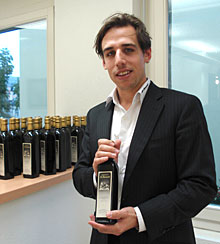 Giovanni gave us a slice of apple first, explaining that the slight acidity in the fruit is perfect for cleansing the palate. He then poured some of the olive oil into a INAO glass (the one that is used for official wine tastings). It was a deep green color, and totally clear. He explained that filtered premium quality olive oil such as his was really the best - it kept for a lot longer (a year to 18 months) than unfiltered olive oil, which only keeps for about 3 months. I had a misconception that unfiltered was somehow better than filtered, so this was a revelation to me. (Unfiltered olive oil also burns very easily - though you really don't want to be using any top quality olive oil for cooking anyway.)
Giovanni gave us a slice of apple first, explaining that the slight acidity in the fruit is perfect for cleansing the palate. He then poured some of the olive oil into a INAO glass (the one that is used for official wine tastings). It was a deep green color, and totally clear. He explained that filtered premium quality olive oil such as his was really the best - it kept for a lot longer (a year to 18 months) than unfiltered olive oil, which only keeps for about 3 months. I had a misconception that unfiltered was somehow better than filtered, so this was a revelation to me. (Unfiltered olive oil also burns very easily - though you really don't want to be using any top quality olive oil for cooking anyway.)
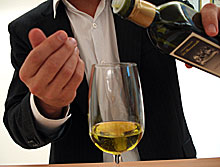 He handed me the glass of olive oil and I swirled it in my hand, as I would a wine, and took a deep whiff. The only way to describe the smell is to say it was like green tomatoes, still on the vine, early in the morning with the dew still on the leaves. I know that adjectives like 'grassy' are often used to describe the smell of olive oil but this was much better than that. It smelled like summer.
He handed me the glass of olive oil and I swirled it in my hand, as I would a wine, and took a deep whiff. The only way to describe the smell is to say it was like green tomatoes, still on the vine, early in the morning with the dew still on the leaves. I know that adjectives like 'grassy' are often used to describe the smell of olive oil but this was much better than that. It smelled like summer.
At this point, a professional taster will slurp the olive oil from the glass, but I felt reluctant to do that. The idea of drinking oil straight up maybe? In any case, we proceeded to taste it in the more conventional way, by dipping cubes of bread in the oil. (White bread is best because it tastes neutral, Giovanni explained.) The oil was as fruity as I expected from the smell, but at the same time it was light and had no cloying aftertaste.
We bought a bottle of it right then and there (as well as a bottle of top quality Modena balsamic vinegar that they also sell).
Tasting at home
The next day, I set up a small olive oil tasting session of my own. I made ready an apple, wine glasses, and small bowls for dipping into. I poured out some oil from the three we had, all extra virgin oils; an AOC olive oil from Le Baux area in Provence (from the Moulin Jean-Corneille), the Di Bennardo olive oil, and finally the everyday olive oil that we use for cooking, the house brand oil (which comes from Spain) from the Migros supermarket. Price wise the Provence olive oil is a bit more expensive than the Di Bennardo, and the supermarket one is the cheapest of course.
Giovanni had told us that there are three criteria used by tasters for judging olive oil : color, odor and sapor or acidity. So first I checked the color. The Provence one is unfiltered so has a cloudy appearance, and is also yellow rather than green. The Di Bennardo one is a deep olive green, and totally clear. The supermarket one is surprisingly green also, and clear.
Then I deeply sniffed each one. The Provence oil had light fragrance, though it had the most olive-like one of them all. The Di Bennardo oil had that green-tomato smell. The Spanish supermarket oil was also surprisingly fruity, with a more pronounced grassy smell.
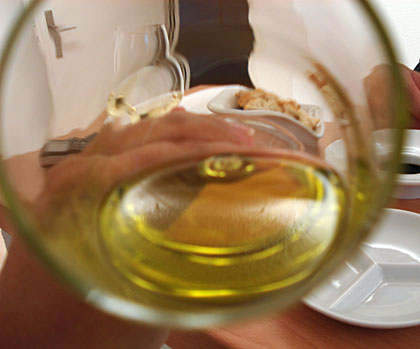
Finally I took a sip from each (getting over my "ew, drink oil?" reaction. It's really not so bad). The Provence one was quite smooth and neutral, slightly nutty, with little aftertaste. The Spanish one had a pronounced pepperiness, though not unpleasant. The Di Bennardo one was definitely the most fruity one, with almost no pepperiness. That peppery flavor comes from the level of acidity; the Di Bennardo olive oil label indicates that it's guaranteed to have less than 0.3% freeacidity, while the supermarket oil says it's less than 0.7%. (The Provence oil didn't indicate any acidity level.) So as luck would have it, I compared three very different oils. I think this is going to help me to judge other olive oils in the future. I've had olive oils that were so peppery that they almost made me gag - those must have had quite high acidity.
Later that night we tried the Di Bennardo and the Provence oil on plain lettuce salads. The fruitiness of the Di Bennardo definitely enhances the flavor of the vegetable, though the Provence one was also very good in a different way.
Marketing a family product
The other interesting aspect of visiting the Di Bennardo office was gaining some insight into how a small family company was marketing its product. Giovanni Di Bennardo is actually still a law student at the University of Zürich. (His father immigrated to Switzerland from Sicily many years ago.) Five years ago, when he was 22, he bought 300 bottles of olive oil from his uncle, who owns the family farm down in Sicily, and started marketing them in his way. Last year they produced 60,000 bottles, and he's been so busy that his studies are on hold. He told us his favorite marketing method was to pick up the Gault Millau restaurant guide and call them up to see if they would be interested in trying his oil. It's been quite successful since he's convinced several top restauranteurs to use, and endorse, his product.
They also put a lot of effort into packaging - the label is an old family photograph, to emphasize the fact that it is a family business; the bottle is made of dark glass to protect the oil from light, and sealed with foil. They also have wooden presentation boxes with laser-edged labels, for corporate gifts and the like. It all adds up to the image of high-end and quality. They've even published a small book, La Cucina di Bennardo, describing the family and the farm, with lots of photos and recipes of course.
They also enter the oil into international tasting contests. Giovanni said that the International Olive Oil Award (IOOA), which is held annually in Zürich, is one of the best - it's a true international contest with worldwide entrants, and is also quite neutral, since Switzerland is not a major olive oil producing country. (Di Bennardo won the gold award in 2004 and placed third in 2006.) Winning an award can mean a lot to a small producer.
At a time when giant international corporations dominate the food manufacturing business, it's quite interesting to see how a small company can push itself forward. It's not just about how good something tastes - it's how it's sold. Prior to Giovanni's attempts, his uncle sold most if not all of his oil production to local outlets in Sicily. Now they sell almost all of it to restaurants and gourmet stores in Switzerland, and they've just contracted with a distributor in New York to sell to the U.S. market.
I have a feeling that they have a good chance to be quite successful.
The Di Bennardo olive oil isn't being sold outside of Switzerland yet though they are just now branching out to other markets. In Zürich you can buy it at Jelmoli, Marinello, and the Wednesday specality food market in the Hauptbahnhof, as well as directly from the the web site.
A few other olive oil facts
- The best olive oil is made from unripe olives, because the riper the olive, the more moisture it contains, and the less concentrated the taste. Also ripe olives oxidize much faster, making the oil too acidic.
- The best olive oil olives are picked by hand, which ensures that the fruit is not bruised. (I forgot to get a picture of the wooden olive picker...I want one, it's cute!)
- Harvest time for the unripe olives is October. This means that the olive oil pressed that season comes to market around January to March. Unlike red wine, olive oil does not age well - it's best consumed up to a year after production if filtered, and up to 90 days if unfiltered/cloudy. Check for either a manufacturing date or a 'best by' date.
- Modern olive oil production ensures that the olives are not exposed to air. Olive oil production is a lot about controlling and suppressing the level of acidity.
- Cheap olive oils are often blended with other oils in order to meet the maximum allowed acidity level (0.8%) allowed by the European Union.
- Top quality oils will often have a batch number printed on the label, in case there is a problem; the maker can track problems by that number.
- The major olive oil producing countries are Italy, France, Spain and Greece, but many other countries produce it too, such as Turkey, Israel and Australia. (There are small scale olive oil producers in southern Switzerland too.)
- I asked Giovanni about the differences between oils from different regions of Italy. He said that in his opinion, the oils from Tuscany tend to be heavier or richer, making them suited to the local cuisine; the oils from Liguria are light; and the oils from Sicily are very fruity. He may be biased but it would be interesting to compare them. (For what it's worth, Nigella Lawson mentions several times in her books that she loves Ligurian olive oil.)
- Further reading: Olive oil tasting resources at aromadictionary.com, and an olive oil tasting account on 101cookbooks.com. (There they used shot glasses, but to me the wine glass makes better sense, since you can really get your nose in there and sniff.). Also, Trader Joe's guide to olive oil(PDF) is pretty good.
If you enjoyed this article, please consider becoming my patron via Patreon. ^_^

 Welcome to Just Hungry, where we serve authentic Japanese recipes and more! I'm
Welcome to Just Hungry, where we serve authentic Japanese recipes and more! I'm 














Comments
Jul
7 October, 2006 - 16:50
Permalink
An education in olive oil
Mmmm. I'm going to have to try one of those degustations...
JK
1 November, 2007 - 07:19
Permalink
Extra Virgin Olive Oil
The Trader Joe's guide seem to indicate that Extra Virgin Olive Oil can be used for frying an deep frying.
However I read otherwise from other articles. Some say that the Extra Virgin Olive Oil should only be used for salad dressing and not for frying or sauteing.
What's your view on this?
Tks
maki
1 November, 2007 - 10:22
Permalink
extra virgin olive oil for deep frying
Well, for one thing e.v.o.o. tends to be quite expensive, so using it for deep frying seems to be a waste! When e.v.o.o. is heated up the small particles of olive in it can get burned, or at least they will lose their flavor. So I use a 'light' oil for deep frying (usually safflower or peanut). I do use olive oil for stir-frying, but not the really good expensive kind!